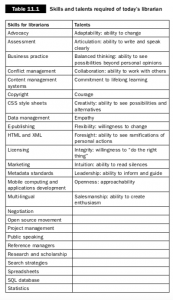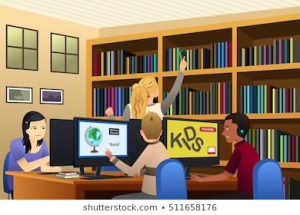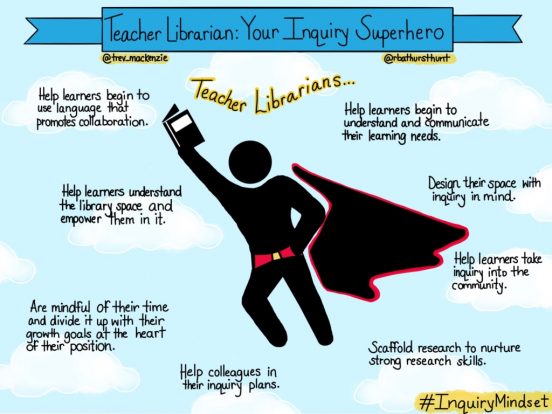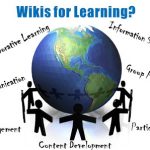“…while the great age of libraries is coming to an end, the great age of librarians is just beginning” (Plutchak, 2012).

As our world becomes increasingly digital, one may wonder if technology may begin to overtake our beloved books, or if libraries will become obsolete. The further into this program I delve, the further away that possibility seems. The reality is that the stereotype of the quiet space to read and study is being transformed into a busy (and yes, sometimes even loud) place to construct, explore, and collaborate with others. It is a place of enthusiasm and curiosity. In light of these changes, the role of the librarian must change as well. While it can be challenging to keep pace with such quick moving technology, we must remember that “lifelong learning is not just something librarians need to install in patrons; they also need to practice it themselves (Allison 2013). Librarians must constantly learn in order to provide the best possible reference services to his or her students and to share best practices with colleagues. We can no longer continue to do things just because that’s the way it has always been done.

The first, and arguably the most important, step in upping the TL game is the way in which we assist students and other patrons. In years past, when a student approached the librarian with a research question, students were likely pointed towards a card catalogue or a set of encyclopaedia. Even for ready-reference questions, the process may have been somewhat lengthy. Now, with the advent of the internet, teacher librarians are able to perform a quick search for the information they need in order to relay it to the student. Beyond this though, the reference interview has changed quite a great deal. Not only must librarians excel at communication skills and have an excellent knowledge of the contents of their collection, but they must also be able to help students figure out which type of resource will best fit their needs. They must be familiar with various models of research so that they may be of the best service to their students. They must provide students with not only information, but with skills to promote information literacy so that students may then go on to be able to apply what they’ve learned to other projects or situations. The following table puts into perspective exactly the skill set that is required of teacher librarians.

Image Source: www-sciencedirect-com.ezproxy.library.ubc.ca/book/9781843347361/the-patron-driven-library
While this lengthy list may seem daunting, Riedling points out that the success of the interview may not actually depend on whether or not the student has retrieved the information he or she was seeking. She says, “a successful reference interview, using the most skilled questioning techniques, may not conclude with the complete achievement of the student’s information needs (full and precise answer). However, if the student feels satisfied that he or she has been given adequate attention and has been directed to accurate resources, the interview process was, indeed, a success” (Riedling 104). In other words, success is more about human relations than about the passing on of information.
Managing the collection, particularly the reference collection, has become a much different job than it once was. Many librarians have opted to go digital for much of their reference section given the cost associated with reference books as well as how quickly they become outdated. Also, libraries may now also house a makerspace, various types of coding and technology, and moveable seating and work surfaces.

Traditionally, the reference section of a library has consisted of bulky shelves for the oversized volumes as well as seating so that one may use the books without having to take them out of the library as these were not for circulation. This traditional model of the reference section no longer fits with the overall message of the modern library or library learning commons. While it is important for a library to offer both print and digital resources, various sets of encyclopaedia are no longer needed. Many reference books can be added to the nonfiction section for circulation as well. Our goal as teacher librarians is to put information (and books) into students hands. Allowing the circulation of more books will encourage that message.

I came across an excellent blog called “Collection Weeding as Dendrochronology: Rethinking Practices and Exposing a Library’s Sponsors of Literacy,” written by Buffy Hamilton, a teacher librarian who chronicles the brutal weeding of her school’s library. She says “our intent was not to devalue the importance of a print collection, but instead, we wanted to rethink how we approach collection development to better meet the needs of our students and faculty and to better support the library as a learning studio” (Hamilton 2014). Hamilton goes on to say that “in our efforts to embrace many mediums for learning […] our profession has inadvertently devalued weeding” (Hamilton 2014). Teacher librarians are often reluctant to weed or redesign, due in part to the fear of not having enough funding to replace what they remove and “it can be challenging to refocus from collections to patrons when the workforce includes staff members who were hired in a print world and now must transition into the digital world” (Allison 2013). Teacher librarians must shift our thinking to include digital as well as print. We must evaluate the choices of resources based on accessibility, usefulness and cost-effectiveness. This makes the selection and weeding process much more complex than it was many years ago, but it will also make for a very well-used and helpful library. “The library of today must be built for users” (Allison 2013).
In my reading, I came across an incredible video featuring an interactive wall with interactive tabletops.
This amazing technology is featured at a public library in the Netherlands. While all of us teachers in the public school system would love to have technology such as this, the chance of that happening is slim to none with our current budget. In the same way, there are incredible displays and uses of technology that are featured in some school libraries at which we may be envious. We must not lose sight of the goal of resource-baed learning, however. “Resource-based learning actively involves students, teachers, and teacher-librarians in the effective use of a wide range of print, non-print and human resources. Resource-based learning fosters the development of individual students by accommodating their varied interests, experiences, learning styles, needs and ability levels” (Mueller 2020). While we may not have the funds we would like at times, our job as teacher librarians is to help students to find the information they seek, to provide them information literacy skills, and perhaps most importantly, to help them feel success. The feeling of success has nothing to do with budget at all.
Bibliography:
Allison, Dee Ann. The Patron-Driven Library: A Practical Guide for Managing Collections and Services in the Digital Age. Chandos Publishing, 2013. Retrieved from: https://www.sciencedirect.com/science/article/pii/B9781843347361500118
Asselin, M., Branch, J., & Oberg, D., (Eds). Achieving information literacy: Standards for school library programs in Canada. Ottawa, ON: Canadian School Library Association & The Association for Teacher-Librarianship in Canada, 2003. Retrieved from: http://accessola2.com/SLIC-Site/slic/ail110217.pdf
Bradigan, P. & Powell, C. (2004). The Reference and Information Services Team: An Alternate Model for Managing Reference Services. Reference & User Services Quarterly, 44(2), pp.143-148. Retrieved from: www.jstor.org/stable/20864330
Hamilton, Buffy J. (January 26, 2014). Collection Weeding Dendrochronology: Rethinking Practices and Exposing a Library’s Sponsors of Literacy. Retrieved from: https://theunquietlibrarian.com/2014/01/26/collection-weeding-as-dendrochronology-rethinking-practices-and-exposing-a-librarys-sponsors-of-literacy/
Mueller, Aaron and Greater Victoria School District. Lesson 7: Evaluating Reference Services, 2020. Lecture Module. Retrieved from: https://canvas.ubc.ca/courses/37516/pages/lesson-7-evaluating-reference-services?module_item_id=1190553
Plutchak, T.S. (2012) Breaking the Barriers of Time and Space The Dawning of the Great Age of Librarians. Journal of the Medical Library Association, 100(1), pp.10-19.
Rendina, Diana. (February 14, 2014). 3 Reasons to Rethink your Reference Section. Retrieved from: www.renovatedlearning.com/2014/02/14/3-reasons-to-rethink-your-reference-section
Riedling, Ann Marlow, et al. Reference Skills for the School Library: Tools and Tips, 3rd ed., 2013.
Featured image source: journal.canadianschoollibraries.ca/classroom-inquirys-secret-weapon-the-teacher-librarian/

 Follow
Follow






Aaron Mueller
February 26, 2020 — 7:50 am
Well done reflection post that was quite effective in sharing your ideas, new learning, honest reflection and great advice. I especially appreciated your discussion and connection with Buffy Hamilton and her advice and observations on collections and the need for purposeful weeding. Your use of images, links and other media was well done (apart from the blurry list) and provided an engaging entry point for your visitors and readers. A good overview of all the key takeaways from our course so far and some plans for going forward. Great stuff.
melissa hunt
February 26, 2020 — 1:39 pm
Not sure what happened there with the list! I’m going to have a look at it to see if I can fix that.
jennifer jack
March 1, 2020 — 8:49 pm
Melissa,
Your blog reminds me of the reluctance of the TLs where I work to weed/deselect materials. When I took a closer look at the collection last I was shocked that the AV collection was 80% video tapes, and further surprised to discover that there are still two teachers out of 80 that use VHS but only from their own collections and not from the school library.
The print collection is also largely from before the year 2000 and neither of the TLs is confident/comfortable with technology so the digital collection is not as broad as it could be. The budget is very healthy as not much has been spent in the past few years but it is a case of “spend it or lose it” so there is a risk that the funds could be clawed back if no spent.
I think there is a fear that if they set a weeding policy designed to work towards creating a collection that is more current that the shelves would be very bare in the reference section and then people may assume the library does not have a strong collection. This is further compounded by the school being on the seismic upgrade/replacement list as we do not know if there will be remediation or replacement of the building. In either case, the collection will need an overhaul to bring it further towards an LLC.
j2